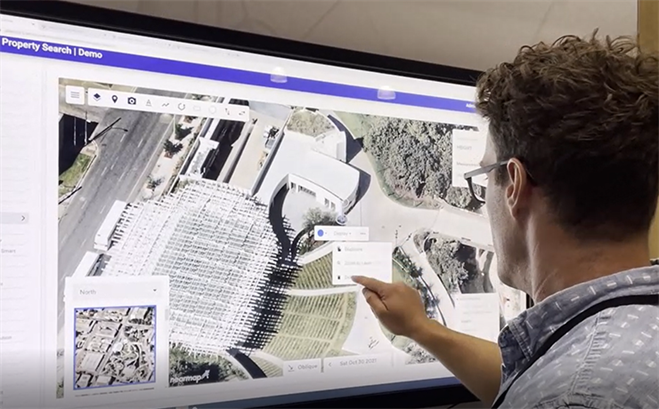Five Ways Assessment Offices Can Modernize Using Technology
February 22, 2023 by Peter Friesen

Experts in the property appraisal and tax industry agree that one of the most critical questions modern appraisers and assessors ask is: What are the best technology solutions for my assessment office?
In a recent webinar, The Modern Assessment Office: What Technologies Work and Why, held by IAAO Studios, four experts provided insight to various new imaging capabilities and data available to modern assessors — all accessible within Tyler’s core computer-assisted mass appraisal (CAMA) platform in the cloud.
The advantages of being in the cloud include agility and ability to access information. These benefits are recognized by more and more jurisdictions, with 75% of requests for proposal in recent years specifically asking for cloud-hosting, according to Tim Bross, solutions consulting team lead for Tyler Technologies.
Aside from the benefits of general cloud capabilities, the panel arrived at five other critical functions or enhancements that best aid a modern assessment office.
1. Aerial and Oblique Imagery
First, Steve Santovasi, solution product manager for Nearmap, shared images of just how advanced new camera systems, aerial imagery, and feature extraction technologies have become. With the advent of Nearmap AI, assessors can leverage advanced location intelligence to help identify and detect change in their environment. This includes more than 120 identifiable features like pools, solar panels, trampolines, roof characteristics, and impervious surfaces.
Nearmap provides up-to-date, aerial and oblique imagery so neighborhood changes, property updates, and more can be recorded and addressed—with a birds-eye view down to the nearest few inches.
2. Street-Level Imagery
“If you can see it, we can extract data from it, we can measure it, and you can share it with other departments and agencies … and when you can do that, you find other stakeholders to share in the costs,” commented Alex Hepp of Cyclomedia. Cyclomedia delivers high-quality street-level imaging and panoramic views — allowing assessors to view more angles around properties to boost valuation accuracy.
Hepp mentioned, “Data analytic projects are becoming more prevalent … and it allows you to do your work faster and more efficiently without having to go out in the field constantly.” And, consider our initial question of sourcing and compiling all this information — how do modern assessors manage to locate, access, compare, and verify all the data needed to accurately value properties?
3. Commercial, Industrial, and Financial Data
Lonnie Hendry, senior vice president and head of CRE and Advisory at Trepp Inc., knows assessors have some occupational challenges, and offered that, “if you don’t have good income and expense data, it’s very difficult to build accurate assessments.”
With limited time and staffing for assessment operations, property appraisal and tax offices often leverage third parties and agencies for comparative intel. Trepp Inc. looks beyond traditional assessment datasets and accounts for a more holistic view of finance markets. Accessing this complex financial data, Trepp aids jurisdictions in calculating a more accurate property value.
4. Exemption Monitoring
Another powerful capability offices can tap into is exemption monitoring and validation. Tyler Masterson, co-founder and CEO of TrueRoll, revealed that, “it ends up being fairly easy to calculate the missing revenue to a jurisdiction related to missing exemptions — fraudulent or inaccurately applied exemptions. Multiplying your exemption benefit totals by an expected fraud rate of between 2% and 4% gets you to your annual loss estimation.”
The company, TrueRoll, excels at assisting organizations in identifying and uncovering unqualified and unclaimed exemptions via data science and AI. Tyler suggested that while performing a single point in time audit can be helpful, adding automated and proactive controls to flag and remedy unqualified exemptions as they become unqualified is a more sustainable and modern method of compliance.
Example: 100,000 (number of exempt parcels in a jurisdiction) x $500 (average value of an exemption annually) = $50M in exempt value $50M in exempt value x 0.02 (the percentage of unqualified exemptions on any given tax roll) = $1M of annual recoverable revenue in unqualified exemptions.
Tyler Masterson
TrueRoll
5. Cloud Capabilities
Finally, after Lonnie Hendry noted the importance of USPAP and FIRREA compliance in appraisal valuations, Tim Bross closed the webinar with thoughts on the cloud and what he called, “the new frontier of advanced, on-demand computing.” With cloud operations, offices can benefit from simpler workflows and more capabilities than traditional on-site software solutions. Bross stated, “It really is an exciting time.”
Though property appraisers are challenged with arriving at the most fair, equitable, and defendable value for a parcel, they can rely on advanced tools, functions, and integrations to make the best decisions.
Critical Core CAMA
Having an agile, efficient, and trusted CAMA solution like Tyler’s that leverages these key capabilities can make assessor’s lives easier and can help to deliver the most accurate valuations in the marketplace. With a modern, core CAMA solution like Tyler’s Enterprise Assessment & Tax, your office can manage the entire land and property development lifecycle with technology transformations for the better.
To watch the entire recording, visit the webinar landing page.